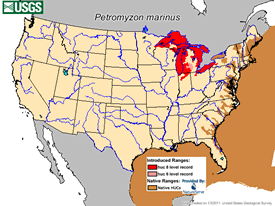Home | Detectives | Suspects | Background Check | Kids' Headquarters | Top Desk Administrator | Case Files
Petromyzon marinus
THE CRIMES: Hurts lake trout population, which affected commercial fishing in mid-1900s. Can kill or injure native fish. Creates problems for those who like to fish by leaving nasty scars on their catch.
DESCRIPTION: Parasitic, eel-like fish that is grey-blue on its back and silver-white underneath. It is from 30.48 – 50.8 cm (12-20 inches) long and has a tooth-lined disc shaped mouth.
The Interrogation
Where are you from?
I came from the Atlantic Ocean and from the Mediterranean Sea.
How did you get here?
We first got to Lake Ontario through the St. Lawrence River. By the late 1800s,
the lumber industry was causing problems for native fish in Lake Ontario. The water got warmer because
shade trees were chopped down so native fish populations like Atlantic salmon went way down. At the
same time our numbers were growing and we really started to populate that lake. Then when the Welland
Canal was modernized in 1919, I was able to easily escape into Lake Erie because of this deeper pathway
between Lake Ontario and Lake Erie.
What’s your problem?
In the mid 1900s, I fed off of your native fish in the Great Lakes. My favorites are
lake trout, burbot, and whitefish. Thanks in part to me, the lake trout population declined severely,
thus affecting its commercial fishing industry by the 1950s. Today, I also do a number on your favorite
sportfish when I attach to these fish and suck their fluids in order to satisfy my appetite. They either
die or are left with a nasty scar.
How can we control you?
Chemicals called lampricides are put in the water at selected spots upstream from where
we nest because it is easier to kill us when we are really young. You see I’m weakest in my early
development stage. Even Walleye and Lake Sturgeon eat us in this stage. The new trick is
“chemical warfare” where biologists also go out and collect male lamprey and sterilize them to
reduce the success of sea lamprey spawning. When the sterilized males are released back into streams they
compete with normal males for spawning females, reducing the next generation. Electric barriers are another
way you humans try to keep me from traveling upstream to nest. Sometimes humans build dams that are small
enough for fish to leap over them, but too high for us to pass through.
Reward:
The honor of protecting our water resources— A healthier environment
and more opportunities to enjoy our natural areas.
